There are certain basic things that a 110/100 hurdler needs to do in order to run fast. Coaches should constantly be looking for these things, and athletes should constantly be working on their weaknesses in these areas. This article will identify some of the basics and provide an explanation for each.
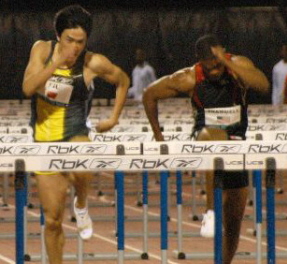
Lead with the knee
Many beginning hurdlers, and many experienced hurdlers who were never taught any differently, swing their lead leg from the hip instead of driving the knee of the lead leg at the crossbar. A bent lead leg will make for more speed, a more horizontal flight over the hurdle, and a quicker return to the ground. The heel of the lead leg should be tucked underneath the butt as the lead knee drives forward. Make sure the lead leg continues to snap down all the way to the ground. Keep pulling the foot (with the ankle flexed) under you so that that it does not land in front of your hips.
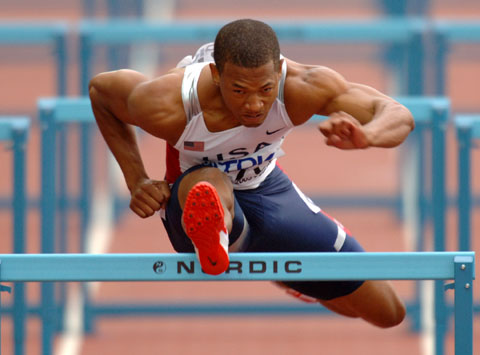
Rotary lead arm
The lead arm should stay as close to how it is in normal sprinting motion as possible. The hand of the lead arm should never cross the nose of the face, and should never raise any higher than the forehead. The elbow should open up just wide enough for the trail leg to drive through in its upward motion. The elbow should never be in a position where it is higher than the hand. The lead arm should begin its downward motion before the lead foot reaches the crossbar. The elbow should remain bent as you drive the lead arm back down. Hand should return to the back pocket as you return to sprinting.
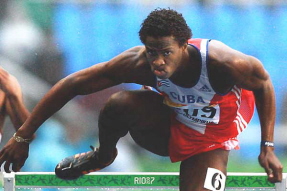 Rotary trail leg
Rotary trail leg
In beginning its motion, the trail leg should leave ground almost at same time as the lead leg. The heel of trail leg should tuck underneath the butt (not kick back), and the knee of the trail leg should drive upward in a tight, circular motion. At no time during hurdle clearance should the foot of the trail leg be higher than the knee. The toe of the trail leg must be pointing upward to avoid hitting the crossbar. As the lead arm punches down, the knee of the trail leg drives upward. As the lead leg descends, you must “close the door” of the trail leg, making sure there is no width in the groin once the lead leg lands. The knee of the trail leg should be facing the next hurdle when the lead leg lands. The trail leg should touch down almost at the same time as the lead leg.
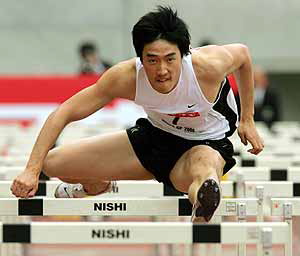
Trail arm punches down, punches up
The hand of the trail arm should go straight to the back pocket as the lead leg drives at the crossbar, and then punch back up into running motion as the lead leg descends. The elbow of the trail arm should remain bent throughout hurdle clearance. The trail arm should never swing backward, swing outward, nor twist to where the hand is behind the back.

Chest over thigh
During take-off, the chest should push down over the thigh of the lead leg. Your lean must come from the waist and lower back, not from the upper back. The eyes should face forward and the chin should remain up. If you lean from the upper back and allow the forehead to face the knee of the lead leg, the chest won’t be pushing down, and the lead leg will straighten out over the hurdle, which will delay snapdown of the lead leg, which will delay the motion of the trail leg.
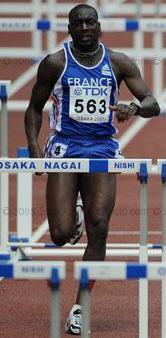
Short last stride
The last stride into the hurdle has to be shorter than the previous stride to ensure that you will be able to thrust yourself into the hurdle, and accelerate off the hurdle. The hips have to be under the lead foot at take-off. If the eighth step (first hurdle) or third step (rest of them) is too long, trouble will occur. Hurdlers just learning how to 3-step often take bounding strides between the hurdles, and might be better off 4-stepping until that third step can be taken without overextending. For experienced hurdlers or faster hurdlers, if the last stride is too long, crowding will occur, which will cause the lead foot to hit the hurdle on the way up.
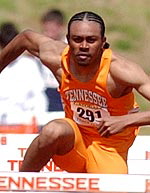
Relax
Facial muscles, neck, hands, forearms, should all remain relaxed throughout a hurdle race. Extraneous effort will increase fatigue and speed up its onset.
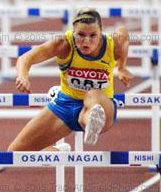
Hip thrust
The hips should drive forward as much as possible during take-off in order to eliminate the vertical element in hurdle flight. Only men going over 42-inch hurdles need to elevate the hips, and even they should try to minimize the elevation by rolling the hips upward and forward simultaneously.

Run tall
All strides between the hurdles should be on the balls of the feet, with minimal back-kick, and with the feet landing underneath the hip. Toes pointing downward can cause for swinging from the hip, and can also cause a wide, slow trail leg. Running on the balls of the feet is also important for creating the feeling of looking down on the hurdle, or making the hurdle small.
© 2007 Steve McGill
